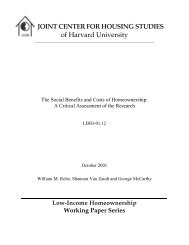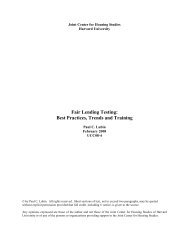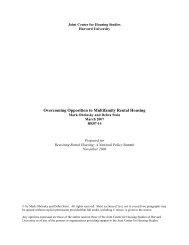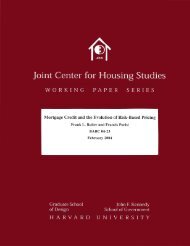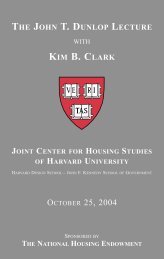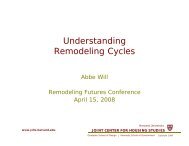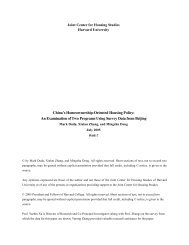please do not cite or circulate without permission of the authors
please do not cite or circulate without permission of the authors
please do not cite or circulate without permission of the authors
You also want an ePaper? Increase the reach of your titles
YUMPU automatically turns print PDFs into web optimized ePapers that Google loves.
community districts where Nehemiah <strong>or</strong> Partnership New Homes projects were<br />
developed, our sample includes 300,890 sales. 9 Because <strong>of</strong> <strong>the</strong> long time span <strong>of</strong> <strong>the</strong> data<br />
and New Y<strong>or</strong>k City’s size, <strong>the</strong> sample size is large compared too much <strong>of</strong> <strong>the</strong> literature.<br />
Second, we have supplemented <strong>the</strong>se transactions data with building characteristics<br />
from an administrative data set ga<strong>the</strong>red f<strong>or</strong> <strong>the</strong> purpose <strong>of</strong> assessing property taxes (<strong>the</strong><br />
RPAD file). The RPAD data contain inf<strong>or</strong>mation about buildings and <strong>do</strong> <strong>not</strong> contain<br />
much inf<strong>or</strong>mation about <strong>the</strong> characteristics <strong>of</strong> individual units in apartment buildings<br />
(except in <strong>the</strong> case <strong>of</strong> con<strong>do</strong>miniums). 10 None<strong>the</strong>less, <strong>the</strong>se building characteristics<br />
explain variations in prices surprisingly well (perhaps because over 70 percent <strong>of</strong><br />
buildings are ei<strong>the</strong>r single-family <strong>or</strong> two-family homes). Using all transactions in 1998, a<br />
regression <strong>of</strong> <strong>the</strong> log price per unit on building age and its square, log square feet per unit,<br />
<strong>the</strong> number <strong>of</strong> buildings on a lot, and dummies f<strong>or</strong> <strong>the</strong> presence <strong>of</strong> a garage,<br />
aban<strong>do</strong>nment, maj<strong>or</strong> alterations, <strong>the</strong> presence <strong>of</strong> commercial units, and location on a<br />
block c<strong>or</strong>ner yields an R 2 <strong>of</strong> 0.46. When a set <strong>of</strong> 18 building classifications is added to<br />
<strong>the</strong> regression (f<strong>or</strong> example, “single-family detached,” “single-family attached,” “tw<strong>of</strong>amily<br />
home”), <strong>the</strong> R 2 rises to 0.68. Finally, when community district dummy variables<br />
are added as well, <strong>the</strong> R 2 rises to 0.78.<br />
Figure 1 shows summary statistics from <strong>the</strong> RPAD data. The first column shows<br />
characteristics <strong>of</strong> our full sample; <strong>the</strong> second shows <strong>the</strong> characteristics <strong>of</strong> sales located<br />
within 500 feet <strong>of</strong> a Nehemiah <strong>or</strong> Partnership site, whe<strong>the</strong>r completed <strong>or</strong> <strong>not</strong>. As shown,<br />
nearly three-quarters <strong>of</strong> all buildings sold were ei<strong>the</strong>r one- <strong>or</strong> two-family homes, and over<br />
92 percent were ei<strong>the</strong>r one-family homes, two-family homes, <strong>or</strong> small apartments. Most<br />
sales were located in Brooklyn and Queens, both because <strong>of</strong> <strong>the</strong> location <strong>of</strong> <strong>the</strong><br />
because cooperative apartments tend to be under-represented in <strong>the</strong> 34 community districts which have<br />
Nehemiah <strong>or</strong> Partnership New Homes developments.<br />
9 This includes three community districts in Manhattan, nine in <strong>the</strong> Bronx, 12 in Brooklyn, nine in Queens,<br />
and one in Staten Island.<br />
10 It is imp<strong>or</strong>tant to <strong>not</strong>e that most <strong>of</strong> <strong>the</strong> RPAD data in this study were collected in 1999; it is conceivable<br />
that some building characteristics changed between <strong>the</strong> time <strong>of</strong> sale and 1999. However, most <strong>of</strong> <strong>the</strong><br />
characteristics used in <strong>the</strong> he<strong>do</strong>nic regressions are fairly immutable (e.g., c<strong>or</strong>ner location, square feet,<br />
presence <strong>of</strong> garage). Fur<strong>the</strong>rm<strong>or</strong>e, to examine whe<strong>the</strong>r <strong>the</strong> building characteristics tend to remain constant<br />
over time, we merged RPAD data from 1990 and 1999 and found that f<strong>or</strong> eight <strong>of</strong> <strong>the</strong> 10 variables, <strong>the</strong><br />
characteristic remained unchanged in 97 percent <strong>or</strong> m<strong>or</strong>e <strong>of</strong> <strong>the</strong> cases. “Year Built” and “Number <strong>of</strong> Units”<br />
remained unchanged in only 87 and 93 percent <strong>of</strong> <strong>the</strong> cases respectively. We suspect that <strong>the</strong> maj<strong>or</strong>ity <strong>of</strong><br />
<strong>the</strong>se changes are c<strong>or</strong>rections, ra<strong>the</strong>r than true changes, since <strong>the</strong>se characteristics may change very rarely.<br />
Thus, <strong>the</strong> 1999 RPAD file may actually be a better estimate <strong>of</strong> 1990 characteristics than <strong>the</strong> 1990 file. The<br />
aban<strong>do</strong>nment variable was collected in 1980.<br />
11



